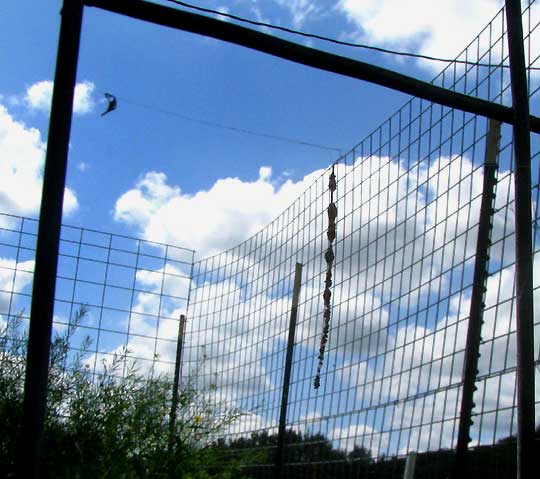Excerpts from Jim Conrad's
Naturalist Newsletter
from the May 12, 2013 Newsletter issued from the Frio Canyon Nature Education Center in northern Uvalde County, southwestern Texas, on the southern border of the Edwards Plateau; elevation ~1750m (~5750 ft); N29.62°, W99.86°; USA
TRASHLINE SPIDER
Tall wire fences to keep the deer out surround both of my gardens. For at least two weeks there's been a special type of orb web strung across one of a wire fence's square holes. What's unusual about the web is that across its center there's a vertical line of what looks like little bundles of odd-sized granular trash or debris. The web's silk strands are so fine that you can't see them unless the sun strikes them just right, so usually it looks as if the line of debris is suspended in mid air, normally vibrating in the wind. Below you can see the line of debris silhouetted against a dramatic sky, the line at first looking like one of the fence poles in the background:

A close-up of the line of debris -- technically known as the stabilimentum -- with a milkweed seed caught among the silk strands, is seen below:

In that picture, the topmost, oval item is the spider's egg sac. If you look a little below the picture's center you'll see the spider herself well camouflaged as debris where all the web's radiating strands come together. Much closer you can see legs and designs on the spider's abdomen, below:

That picture shows the tiny spider's undersides. A more illuminating view from the other side of the web displaying the spider's top and the unusual protrusion at the rear of the abdomen is shown below:

This is a commonly occurring and widely spread spider species, though it is so small and easily overlooked that it bears no good common name. It's CYCLOSA TURBINATA, distributed all across the US and southward as far as Panama. In Texas we have at least five species of the genus Cyclosa, and they all produce webs with such vertical lines of debris across their web centers, so the group of species in the genus are often referred to as trashline spiders. The trashlines consist of the sucked-dry carcasses of prey and sometimes egg bags. When disturbed, the spiders tend to shake their webs back and forth, maybe with the effect of causing larger animals about to crash through the web to back off.
Cyclosa species occur worldwide. Just in the Americas around fifty species are recognized, and probably there are many more. One reason trashline spiders are so widely distributed is that their young "balloon" from place to place -- they climb onto a perch, extrude a line of silk into the air, the wind tugs on the silk as if it were a kite, and when the silk is long enough and the tug powerful enough the spiderling releases its grip and travels on the wind.